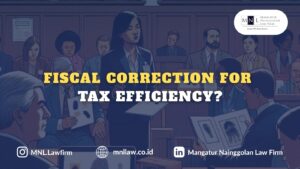
TAX ADJUSTMENT FOR FISCAL EFFICIENCY?
Financial statements and tax returns may be viewed as two sides of the same coin. Both reflect a corporation’s performance, yet serve different purposes: one for business interests, the other for the State. The divergence in standards gives rise to tax adjustments (fiscal corrections), a mechanism designed to align financial statements with tax law requirements.
What is a Financial Statement?
A financial statement is an official record that presents a company’s financial condition during a specified accounting period.
According to Arief Sugiono in his book Practical Guide to the Fundamentals of Financial Statement Analysis, a financial statement consists of four basic reports:
-
-
- Balance Sheet (Statement of Financial Position)
- Income Statement (Profit and Loss Statement)
- Statement of Changes in Equity (Retained Earnings Statement)
- Cash Flow Statement
-
Entities Required to Submit Financial Statements
The obligation to file financial statements applies to:
-
-
- Limited Liability Companies (Perseroan Terbatas / PT) that meet one of the following conditions:
-
-
-
-
- Publicly listed company;
- Engaged in activities involving public fund-raising;
- Issuing debt securities;
- Holding minimum assets of IDR 50 million (reduced to IDR 25 million since fiscal year 2000);
- Acting as a debtor whose financial statements are required by a bank to be audited.
-
-
-
-
- Foreign companies domiciled and operating within the Republic of Indonesia under statutory law, including branch offices, representative offices, subsidiaries, agents, or other authorized representatives.
- State-Owned and Regional-Owned Enterprises, including Persero (State-Owned Limited Liability Companies), Perum (Public Corporations), and Regional Enterprises.
-
Objectives of Financial Statement Analysis
-
-
- Screening – assessment based solely on financial statements.
- Understanding – analysis to comprehend the corporation as a whole.
- Forecasting – projecting the corporation’s future financial condition.
- Diagnosis – identifying managerial or operational problems.
- Evaluation – appraising management performance, efficiency, and achievement of corporate objectives.
-
What is a Tax Return?
A tax return (Surat Pemberitahuan / SPT) is a statutory declaration filed by a taxpayer, reporting tax computation, payment, taxable and non-taxable objects, as well as assets and liabilities, in accordance with tax regulations.
What is a Tax Adjustment (Fiscal Correction)?
A tax adjustment (fiscal correction) is the process of recording, rectifying, and adjusting income and expenses, mandatory for taxpayers, arising from differences between commercial accounting standards and tax accounting rules.
Types of Tax Adjustments
-
-
- Positive Adjustment
-
A positive adjustment increases net income. It occurs when certain deductions from gross income are disallowed under tax law, thereby increasing taxable income and the income tax due. This is governed by Article 9 of Law No. 7 of 1983 on Income Tax, which enumerates costs not deductible from gross income.
-
-
- Negative Adjustment
-
A negative adjustment reduces taxable income due to statutory provisions.
Causes include:
-
-
- Income subject to final income tax or non-taxable income that is nevertheless recorded in business turnover;
- Discrepancies in depreciation or amortization where commercial amounts are lower than fiscal amounts;
- Other negative adjustments not covered by the above.
-
Conclusion
Financial statements and tax returns serve distinct yet interconnected purposes. Differences between Generally Accepted Accounting Principles (GAAP) and tax law create the necessity for fiscal corrections, which reconcile commercial profit and loss with statutory tax requirements.
Legal Basis
Law No. 7 of 1983 on Income Tax.
Author:
Renaldi Avri Angga, S.H.
Yuliana Munthe
Editor:
Muhammad Arief Ramadhan, S.H.
